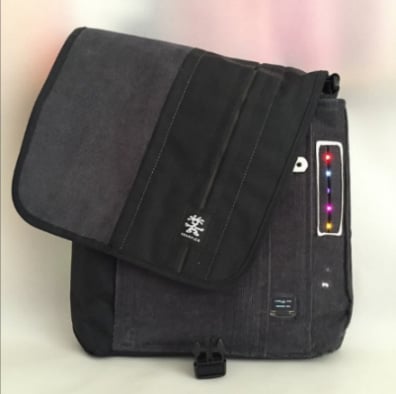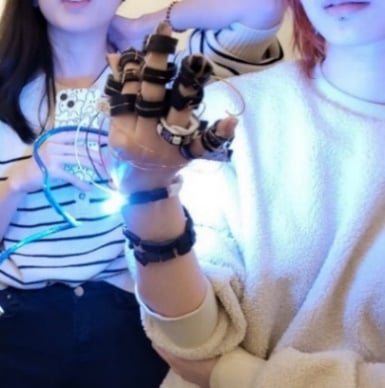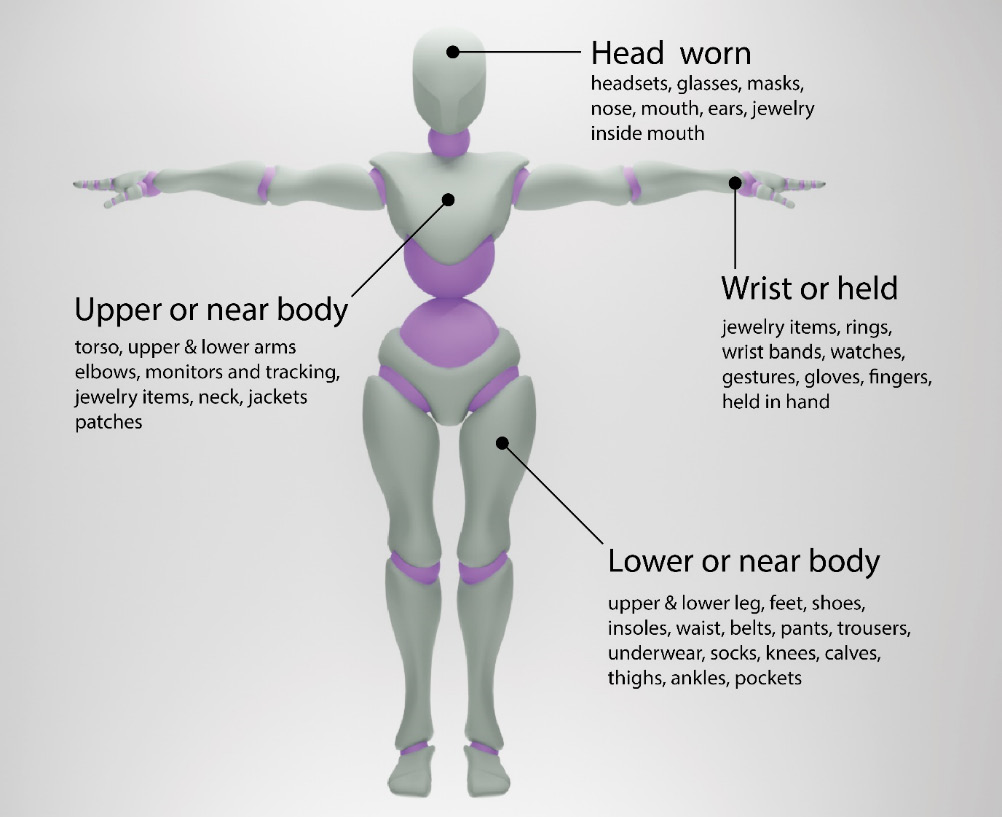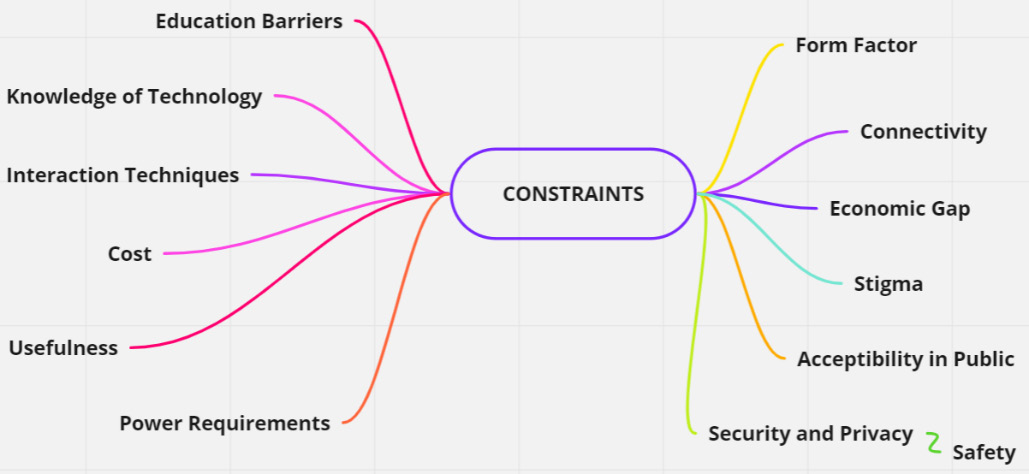Terminology, applications, and constraints
It is important to know the terms you’ll come across in this exciting field. This section will help define some of the terms and will also help you generate your project ideas through understanding the various applications and their constraints. Let’s start with the terminology.
Terminology
This section defines the context for the words that will be used throughout this book. This will give you background information about when they are referred to in this book.
Wearable computing
Wearable computing can be on the body or near bodily items, such as clothing, typically with sensors and outputs. This can be to extend our natural abilities, augment them, or highlight them. It could enable us to communicate with others or track ourselves. The following is an example of an augmented bag:

Figure 1.10 – Wearable computing example, C Farion
Electronic circuits that have processing power that can read input sensor data and output that data in another form are common in most wearable computing. Often, the garment is continuously worn and will have power needs.
The bag in the preceding figure helps a person to remember what objects they have packed. It has computing power to react to sensors and input and also provides output.
Embedded technology
Technology can be placed into garments or fabrics and used in some way to create wearable technology. This can be as simple as circuitry that carries current and performs some actions. Technology that can be embedded into the human body is often called biohacks.
Prototyping
We will explore this in more detail in Chapter 8, Learning How to Prototype and Make Electronics Wearable, but here, our objective is to create something before it is market-ready. This can take many different forms and many iterations to make it work in the way we want it to. This can be done with 3D printing, paper, fabrics, or anything we have to hand. Generally, we use less expensive materials to prototype:

Figure 1.11 – Prototyping example
The preceding figure shows a watch concept made with foam board and lights, with some electronics embedded. The first prototype they made (my Interaction Design students) was just with the foamboard, which is also a good example of prototyping.
Electronic prototyping
This is similar to prototyping, but we use electronic components to create circuits for testing. Here, we connect wires and components to see if they are working and correctly inputting or reacting. This is part of electronic prototyping, so you will be prototyping throughout this book. Generally, we use less expensive components to prototype. Figure 1.12 shows an example:

Figure 1.12 – Electronic prototyping
Once these less expensive components and the circuit configuration have been established, we can start to swap out components for more durable ones.
Interactivity
The term interactivity has many definitions and meanings. In this book, we will use it to describe a button circuit, for example, where pressing that button requires interaction. A person, environment, or sensor that has some type of action and reaction is interactive. Also, when thinking in a wider sense, creating two gloves that connect to people, or wearable items that need to be touched, stroked, or moved in some way, creates interactivity that often enhances a device’s use. Interacting with people or our environment often generates interesting uses:

Figure 1.13 – Anouk Wipprecht, Heartbeat Dress featuring Keenyah Hill, and (right) synapse for Intel
A stunning example of electronic textile technology that combines 3D printed parts is Anouk Wipprecht’s work, as shown in Figure 1.13. It has an extraordinary appearance. The Heartbeat Dress monitors the wearer’s heartbeat and displays the rhythms in a central pendant. This dress was a collaboration with crystal maker SWAROVSKI (https://www.linkedin.com/company/swarovski/), researching Wearable Emotions.
Other work by Anouk that combines fashion and robotics can be viewed online on her website at http://www.anoukwipprecht.nl/. There are many videos that I recommend watching to get a feel for these pieces.
Applications
What are the possible applications and fields that we can design wearables for? This section will provide a list that you can reference when starting new projects.
What types of subject areas do you want to design your wearable for? What inspiration is there? The following diagram shows some of the fields, functions, and constraints of wearables. This will act as a handy reminder when we are developing our projects:

Figure 1.14 – Applications for wearables
Another way we can launch project ideas is to look at specific areas on the body that we may want to design for – especially during the prototyping phase when we are learning new skills. It helps to have some inspiration, and the following figure shows the body location possibilities we have for our designs:

Figure 1.15 – Possible locations (character: https://www.mixamo.com/)
Being aware of the possible locations for using a wearable garment or accessory can be helpful when you are generating ideas. I often refer to this type of guide as a refresher to think through new and exciting ideas that can be developed into a prototype that I can iterate. Hopefully, you have an idea of the different domains to develop for, as well as places on or near the body. Combining these two points of information can help you launch a project idea. Now, let’s look at the constraints and what we need to be aware of when designing wearable technology.
Constraints
There can sometimes be constraints when we are planning and designing wearables. The following diagram shows the constraints that we should be aware of when we are designing wearable technology. How many of these factors will affect your designs?

Figure 1.16 – Constraints
With that, we’ve looked at some common definitions that will be used throughout this book. We also learned about the possible fields where we may make wearables, what their functions might be, and what constraints to be aware of.
This will help you when you’re planning your projects and provide subject inspiration when you are unsure where to start. Now, let’s look ahead to exciting ideas, concepts, and projects to motivate.


























































